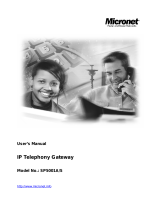Page is loading ...

User’s Manual
SP5050/SP5052/SP5054
IP Telephony Gateway, FXO Interface
Website:
http://www.micronet.info

2
1. INTRODUCTION ....................................................................................................................................... 3
1.1 FEATURES AND SPECIFICATION ................................................................................................................. 3
1.2 APPEARANCE ........................................................................................................................................... 4
2. SYSTEM OPERATING PROCEDURE .................................................................................................... 6
2.1 SYSTEM REQUIREMENT............................................................................................................................7
2.2 TELEPHONE LINE REQUIREMENT ............................................................................................................. 7
2.3 IP ENVIRONMENT SETTING ......................................................................................................................7
2.4 HYPER TERMINAL SETTING...................................................................................................................... 7
3. INITIALIZING VOIP FXO GATEWAY SETTING............................................................................... 10
3.1 GATEKEEPER MODE ...............................................................................................................................10
3.2 PEER-TO-PEER MODE............................................................................................................................. 12
3.3 BEHIND IP-SHARING.............................................................................................................................. 13
4. DISCONNECT TONE CONFIGURATION ........................................................................................... 15
4.1 WHAT IS DISCONNECT TONE .................................................................................................................. 15
4.2 HOW TO CONFIGURE DISCONNECT TONE ON VOIP FXO GATEWAY ......................................................... 15
4.3 ADJUST TONE TABLE PARAMETERS MANUALLY ....................................................................................16
4.4 ADJUST INPUT TONE LEVEL................................................................................................................... 17
5. COMMAND LISTS ................................................................................................................................... 18
5.1 [HELP] COMMAND .................................................................................................................................. 18
5.2 [QUIT] COMMAND................................................................................................................................... 18
5.3 [DEBUG] COMMAND ............................................................................................................................... 18
5.4 [REBOOT] COMMAND.............................................................................................................................. 19
5.5 [FLASH] COMMAND ................................................................................................................................19
5.6 [COMMIT] COMMAND ............................................................................................................................. 20
5.7 [IFADDR] COMMAND............................................................................................................................... 20
5.8 [TIME] COMMAND .................................................................................................................................. 21
5.9 [PING] COMMAND................................................................................................................................... 21
5.10 [GREETRD] COMMAND.......................................................................................................................... 22
5.11 [PBOOK] COMMAND.............................................................................................................................. 24
5.12 [PPPOE] ................................................................................................................................................26
5.13 [SYSCONF] COMMAND .......................................................................................................................... 26
5.14 [H323] COMMAND ................................................................................................................................30
5.15 [GK] COMMAND.................................................................................................................................... 32
5.16 [VOICE] COMMAND............................................................................................................................... 33
5.17 [TOS] COMMAND .................................................................................................................................. 35
5.18 [TONE] COMMAND................................................................................................................................36
5.19 [SUPPORT] COMMAND........................................................................................................................... 36
5.20 [GROUP] COMMAND.............................................................................................................................. 37
5.21 [BUREAU] COMMAND ........................................................................................................................... 38
5.22 [PREFIX] COMMAND ............................................................................................................................. 40
5.23 [ROM] COMMAND ................................................................................................................................. 40
5.24 [PASSWD] COMMAND............................................................................................................................42
6. UPGRADE THE VOIP FXO GATEWAY ............................................................................................... 43
TFTP/FTP SERVER....................................................................................................................................... 43
DOWNLOAD PROCEDURE ............................................................................................................................. 43
APPENDIX: WEB CONFIGURATION ...................................................................................................... 45

3
1. Introduction
The Micronet SP5050 Series FXO gateway provides voice/fax service over IP
network with H.323 v3 protocol. By connecting to your existing ADSL or cable
modem service, which allows the use of a single, network for voice and fax
services with consequent saving in network infrastructure and greatly reduced
telephone charges. Ideal solution for providing low cost communications
between headquarters and branch offices in the world, as well as for SOHO
and office telephony applications.
Micronet SP5050 Series FXO Gateway provides analog lines to connect local
PSTN/PTT interface (FXO), and converts voice/fax signal onto IP network.
The management feature is via RS-232C COM port and TELNET.
1.1 Features and specification
General Features
- ITU-T H.323 v3 compliance
- Automatically Gatekeeper Discovery
- Peer-to-Peer mode (non-Gatekeeper)
- Support auto-attendant (2nddial Tone / Voice greeting)
- Line hunting
- 2(SP5052)/4(SP5054)/6(SP5050) RJ-11 FXO ports
- E.164 (Telephone Number Plan)
- DTMF dialing
- DTMF detection/generation
- TFTP software upgrade
- Remote configuration/reset via Telnet
- LED indication for system status
- LAN interface : One RJ-45 connector of 10Base-T
- Microsoft Netmeeting v3.0 compatible
- Support static IP and DHCP
- QoS by ToS (Type Of Service)
- SNTP (Simple Network Time Protocol)
- Security: Password setting
Audio feature
- Codec -- G.711 a/μlaw, G.723.1, G.729
- VAD (Voice Activity Detection), CNG (Comfort Noise Generate)
- G.168/165-compliant adaptive echo cancellation
- Dynamic Jitter Buffer
- Bad Frame Interpolation
- Call Transfer (H.450.2)
- Call Forward (H.450.3)
- Call Hold (H.450.4)
- Gain Settings
- Provide Call Progress Tone: Dial tone, busy tone, call-holding tone and
ring-back tone

4
Management Features:
- Console port: RS-232C port
- TELNET
- HTTP Brower (e.g. Internet Explorer)
1.2 Appearance
Front panel: The LED light provides system message of Micronet SP5050
Series.
Front panel of SP5050
Power : Light on means Micronet SP5050 Series is power on.
L1-L6 : Light on means the line is in use.
Link : Light on means Micronet SP5050 Series is connected to the network
correctly.
Act : LED should be light on and in flash display when data is transmitting.
Ready : 1. Light on and in slow flash means Micronet SP5050 Series is in
operation mode.
Status : 1. Light on means Micronet SP5050 Series successfully registered to
Gatekeeper when it is set as Gatekeeper Mode.
2. LED flash means Micronet SP5050 Series is not registered to
Gatekeeper when it is set as Gatekeeper Mode.
3. Or when Micronet SP5050 Series is in downloading mode, LED
should be flash as well.
4. Light off means Micronet SP5050 Series is in Peer-to-Peer Mode.
Back panel:
Back panel of SP5050
10 Base-T: RJ-45 Modular Jack Female connector with 10 Mbps Ethernet.

5
PIN 1, 2: Transmit
PIN 3, 6: Receive
COM: RS232 console port (9-pin Male connector, as the same as the computer).
Male connector (as the same as the PC)
9 PIN D-SUB MALE at the VoIP FXO gateway
Pin Name Dir Description
2 RXD
Å
Receive Data
3 TXD
Æ
Transmit Data
5 GND
─
System Ground
L1 ~ L6: RJ-11 (PSTN or Extension Line of PBX)
On / Off: Power switch on/off.
100 - 240 VAC: AC Power supply.

6
2. System Operating Procedure
2.1 System Requirement
2.2 Telephone Line Requirement
2.3 IP Environment Setting
START
END
2.4 Hyper Terminal Setting

7
2.1 System Requirement
1. One PC (a) Pentium 100 or above, 64 MB DRAM, Windows 98 or above.
(b) Network card (RJ-45) & COM port
2. One standard RS-232 straight cable with two female connectors
depended on the different model.
3. PSTN lines / PBX extension lines (up to 4 lines).
4. Software tools (a) Hyper terminal, telnet (Windows OS included) (b)
Gatekeeper (optional)
2.2 Telephone Line Requirement
Two kinds of analog lines can be connected to RJ-11 of VoIP FXO Gateway.
1. PSTN (Public Switched Telephone Network, POTS) or
2. PABX (Private Automatic Branch Exchange) / PBX (Private Branch
Exchange) extension line.
PSTN
1. It is necessary to provide PSTN/POTS telephone lines in order to plug
into RJ-11 of VoIP FXO Gateway.
2. The maximum telephone lines are up to 6 which is dependent on different
model.
PABX / PBX
1. PSTN lines can be replaced to the extension lines of PBX.
Note: Since the Line function feature starts from L1, please plug telephone
lines from L1.
2.3 IP Environment Setting
User must prepare a valid IP address to be complied IP Network policy in
order for VoIP FXO gateway operating correctly.
For example, if your company’s IP address is 192.168.4.111, subnet mask is
255.255.0.0, default gateway is 192.168.1.254, you should prepare one IP for
VoIP FXO gateway, such as IP address is 192.168.4.99, and same subnet
mask and default gateway.
2.4 Hyper Terminal Setting
1. Execute the Hyper Terminal program. Following windows pop-up on the
screen. (START – Program files – Accessories – Communication – Hyper
Terminal)

8
2. Define a name such as ‘SP5050 Gateway’ for this new connection.
3. After pressing OK button, the next window popping up is necessary to
connect choose COM Port.

9
Note: Some connection failed is derived the PC COM Port. If user cannot open
the com port, for example com 1, please try another com port, ex.com port
2.
4. Configure the COM Port Properties as following:
(1) Bits per second : 9600
(2) Flow control : None
Press ‘OK’ button, and start to configure VoIP FXO gateway.

10
3. Initializing VoIP FXO Gateway Setting
3.1 Gatekeeper Mode
(a) Configure VoIP FXO gateway Password
(b) Configure VoIP FXO gateway IP Address
(c) Gatekeeper Mode Settings
START
END
(d) Save VoIP FXO gateway Configuration &
Reboot VoIP FXO gateway

11
(a) Configure VoIP FXO gateway Password
It is important for the first time user to follow the operation procedure.
1. Power on the VoIP FXO gateway and the sentence “Please wait while
system is initializing…………S” is displayed.
Attached TCP/IP interface to cpm unit 0
Attaching interface lo0...done
Please wait while system is initializing .......... S
2. Wait around 40 seconds, the login name and password are requested.
Attached TCP/IP interface to cpm unit 0
Attaching interface lo0...done
AC4804[0] is OK
AC4804[1] is OK
AC4804[2] is OK
Successful
Initialize OSS libraries...OK!
open stack successful
cmInitialize succeed!
GK mode selected.
login:
3. Login: when VoIP FXO gateway is used for the first time, “root” is default
login name without a password.
4. Password setting: type “passwd –set root ****” to define a password for
“root” account. “****”, in above description, stands for contents of the
password. An example, to set root’s password as good, is demonstrated
as following:
usr/config$ passwd -set root good
Setting
login: root
Password: good
OK

12
(b) Configure VoIP FXO gateway IP Address
Use “ifaddr” command to set up VoIP FXO gateway’s IP address and related
network information. An example is demonstrated below:
usr/config$ ifaddr –ip 10.1.1.1 –mask 255.2555.255.0 –gate 10.1.1.254
Note:
this is to assign VoIP FXO gateway an IP address of “10.1.1.1”, subnet mask
“255.255.255.0”, and default IP gateway “10.1.1.254”.
(c) Gatekeeper Mode Settings
To assign a gatekeeper address for VoIP FXO gateway, and define its own
registered ID and phone number. For detail, please refer to Chapter 5.14
[h323] command.
Several H323 parameters are important setting gatekeeper mode:
“–gk”, ”–e164”, and ”–alias”. An example is demonstrated below:
usr/config$ h323 –mode 0 –gk 10.2.2.2 –e164 –alias fxo
Note:
This is to set mode as gatekeeper mode, gatekeeper IP address as “10.2.2.2”,
e.164 number as “1”, and alias name (h323ID) as “fxo” on the VoIP FXO
gateway.
(d) Save VoIP FXO Gateway Configuration & Reboot VoIP FXO gateway
1. Confirming the values, type commit and press enter to save all the
changes you have done.
2. Type reboot and press enter to reboot the VoIP FXO gateway.
3. Wait for VoIP FXO gateway initializing in gatekeeper mode.
3.2 Peer-to-Peer Mode
Peer-to-Peer Mode allows users to call other VoIP devices without using a
gatekeeper. When in Peer-To-Peer mode, VoIP FXO gateway will send
SETUP message directly to the destination IP address once the dial is
finished. Users have 2 methods of dial. One is IP dialing, and the other is
phone book dial, which we will describe later. When using IP address as
destination phone number, press “*” as “.” in IP address expression, and press
“#” when dial is finished. When using Phone book, users can dial predefined
phone number, and press “#” (optional, to accelerate the dial) as end of dial.
To configure Peer-To-Peer Mode in VoIP FXO gateway, follow the steps
below:
1. Set Peer-To-Peer Mode, using “h323” command
usr/config$ h323 –mode 1

13
Note: mode 1 is for Peer-To-Peer (non-gk) mode, while mode 0 is for GK
mode.
2. Configure Phonebook, using “pbook” command.
Users can refer to chapter 5.11 [pbook] command for more information.
usr/config$ pbook –add name TEST1 ip 10.1.1.1 e164 10
Note:
The command is to add a record onto Phonebook. After the command
completed, you can type “pbook –print” to see if the input record is correct.
When adding a record to Phonebook, users do not have to reboot the
machine, the record will be effective immediately.
3.3 Behind IP-Sharing
The function is for user whose network environment is behind IP Sharing
device. It is said VoIP FXO gateway is connected to the IP Sharing device. An
example such as ADSL network is in the following.
ATU-R ADSL Modem
WAN
IP Sharing device
LAN LAN
VoIP FXO gateway
PC
z The WAN IP address obtained from ADSL has two kinds of methods. One
is fixed IP Address, while user applies for one or more fixed IP Addresses.
Another is dynamic IP Address while user applies for dial-up connection
way.
z The LAN IP address of user’s PC can be set as DHCP client in order to
gain an valid one.
z Anther IP address for VoIP FXO gateway must be set as an fixed one in
order for that IP sharing device pass forwarding the relevant information
from WAN to LAN. Besides, a valid IP address which meets the IP
sharing device (LAN site) is the element.
z VoIP FXO gateway must enable the IP sharing function for the fixed /
dynamic WAN IP Address.
Fixed IP Address – usr/config$ ifaddr –ipsharing 1 210.11.22.33

14
Dynamic IP Address –usr/config$ ifaddr –ipsharing 1
Note:
With Dynamic WAN IP Address, a Gatekeeper with a valid IP address for VoIP
FXO gateway is a must. In other word, it is not workable in Peer-to-Peer mode
while dynamic WAN IP Address.
IP Sharing device must have a function to do IP/Port mapping. Some is
named as DMZ, some is named as virtual server. The VoIP messages from
WAN have to completely pass forward to the LAN. It is said if the VoIP FXO
gateway is assigned a virtual fixed IP Address such as 192.168.1.5, IP sharing
device must forward the VoIP messages to 192.168.1.5.

15
4. Disconnect Tone Configuration
This application note is going to describe the procedures of configuring the
disconnect tone on VoIP FXO gateway in order to release LINE ports of VoIP
FXO gateway after PSTN/PBX caller party is hung up.
4.1 What is Disconnect Tone
A caller make a telephone call to gateway from PSTN side, VoIP FXO
gateway will answer the call automatically. If the IP side of other VoIP devices
do not answer the call and the caller hang up the call, the PSTN/PBX will give
gateway a disconnect tone automatically. Or, VoIP FXO gateways are
installed on both sied and connect to local PSTN. If both parties are in talking
mode and one side hang up the call. the VoIP FXO gateway has to recognize
the disconnect tone from local PSTN and release the line port with the
pre-defined busy tone or reorder tone in VoIP FXO gateway tone table.
There are three parameters received from PSTN/PBX.
- High level frequency and Low level frequency
- Tone Cadence (ON/OFF intervals)
- Tone level
These parameters have to be properly configured in VoIP FXO gateway in
order to recognize disconnect tone correctly. Each different PSTN/PBX have
different parameters. So, VoIP FXO gateway has to configure tone table when
line port connect to different PSTN/PBX.
4.2 How to configure disconnect tone on VoIP FXO gateway
VoIP FXO gateway has a default setting of disconnect tone (Busy tone 1,
Busy tone 2, reorder tone 1 and reorder tone 2 ). If the disconnect tone was
recognized correctly, the line port from PSTN/PBX will be released in seconds.
IP-Network
PSTN or
PBX
VoIP
FXO
gateway
Other VoIP
devices
IP Side
PSTN side
Caller

16
Otherwise it may be released after one minute or lock this LINE permanently.
The tone table parameters are shown as follows.
LowFreq 480 : Low frequency is 480 HZ
HighFreq 620 : High frequency is 620 HZ
LowFreqLevel 8 : Low frequency level received range from PSTN/PBX
HighFreqLevel 8 : High frequency level received range from PSTN/PBX
TOn1 50 : Disconnect tone cadence ON time is 0.5 seconds
TOff1 50 : Disconnect tone cadence OFF time is 0.5 seconds
( If this is continuous tone, the Toff has to set to 1023 )
TOn2 1023 : Disconnect tone second cycle cadence ON time is OFF
TOff2 1023 :Disconnect tone second cycle cadence OFF time is OFF
( If the tone cadence has only one cycle, the second cycle must set to 1023 )
(1) Examples how to configure Tone table
a. 480/620 frequency with ON/OFF time is 0.5 seconds
tone -busy1 480 620 8 8 50 50 1023 1023
b. 480 HZ single frequency with continuous tone
tone –reorder2 480 0 8 0 50 1023 1023 1023
(2) There are two ways to analyze the disconnect tone.
a. The first one is using command “greetrd” from VoIP FXO gateway. Once
you follow the instruction to analyze the disconnect tone, gateway will
configure the tone table (Busy tone 1, Busy tone 2, reorder tone 1 and
reorder tone 2 ) with proper frequency and default tone level and cadence
(Ton1/Toff1) automatically. Or you may read the analysis tone frequency
from command line and configure to one of tone table manually.
The default tone level is set to 8. And the tone cadence (Ton1/Toff1) is set
to four different values on tone table. They are 0.1 second, 0.25 seconds,
0.5 seconds and 0.75 seconds with parameters 10/10, 25/25, 50/50 and
75/75.
If the PBX/PSTN cadence is not the value as default shown as above, you
need to use the following instruction to analyze ON/OFF intervals.
b. You may use your PC (START Æ Program Files Æ Accessories Æ
Multimedia Æ Recorder) with Headset or Microphone to record the
disconnect tone via a telephone set from PSTN/PBX and save to a voice
file. Then you can use “CoolEdit Pro” software to analyze the frequency
and ON/OFF time. Please visit http://www.cooledit.com to download demo
version for analysis. You can use this program to analyze ON/OFF time
and fill in to tone table.
4.3 Adjust Tone Table parameters manually
If the gateway still cannot release the LINE port in two seconds, try to adjust
the frequency by 1 hz on tone table. For example, your analysis value is

17
620/480, take the following procedures.
620/479
620/480
620/481
621/479
621/480
621/481
619/479
619/480
619/481
If the line port of gateway was locked, please use “hangup 0” command to
release LINE 1, “hanhup 1” to release LINE 2…etc.
4.4 Adjust Input Tone Level
Sometimes the disconnect tone level is too low to be detected by VoIP FXO
gateway. You can increase input gain from the following command.
voice -volume input xx
commit
reboot
xx is the input gain parameters. The maximum number is 35. if the number is
over 35, the echo may be happened. Once you increase input gain, the voice
volume from PSTN to IP side is increased too.

18
5. Command lists
5.1 [help] command
Type help or man or ? to list all the available command.
usr/config$ ?
help help/man/? [command]
quit quit/exit/close
debug show debug message
reboot reboot local machine
flash clean configuration from flash rom
commit commit flash rom data
ifaddr internet address manipulation
time show current time
ping test that a remote host is reachable
greetrd Greeting voice and Disconnect tone Record mode
pbook Phonebook information and configuration
sysconf System information manipulation
h323 H.323 information manipulation
voice Voice information manipulation
gk H.323 gatekeeper manipulation
tos IP Packet ToS (Type of Service)values
tone Setup of call progress tones
support Special Voice function support manipulation
group Grouping setting information and configuration
bureau Bureau line information manipulation
prefix Prefix information manipulation
rom ROM file update
passwd Password setting information and configuration
usage: help [command]
5.2 [quit] command
Type quit will quit the VoIP FXO gateway configuration mode. And turn back to
login prompt.
usr/config$ quit
Disconnecting...
login:
Note:
It is recommended that type the “quit” command before you leave the console.
If so, VoIP FXO gateway will ask password again when next user connects to
console port.
5.3 [debug] command

19
Open debug message will show up specific information while VoIP FXO
gateway is in operation. After executing the debug command, it should
execute command debug -open as well. One example is demonstrated
below.
usr/config$ debug -add h323 vp
usr/config$ debug -open
Parameters Usage:
-status Display the enabled debug flags.
-add Add debug flag.
-- h323 : h323 related information
-- vp : voice related information
-delete Remove specified debug flag.
-open Start to show debug messages.
-close Stop showing debug messages.
5.4 [reboot] command
After commit command, type reboot to reload VoIP FXO gateway in new
configuration. The procedure is as below:
usr/config$ reboot
Attached TCP/IP interface to cpm unit 0
Attaching interface lo0...done
AC4804[0] is OK
AC4804[1] is OK
AC4804[2] is OK
Successful
Initialize OSS libraries...OK!
open stack successful
cmInitialize succeed!
GK mode selected.
login:
5.5 [flash] command
This command will clean the configuration stored in the flash rom and reboot
VoIP FXO gateway in factory default setting.
Parameter Usage:
-clean clean all the user-defined value, and reboot VoIP FXO gateway
in factory default mode.
Note:
It is recommended that use “flash –clean” after application firmware id
upgraded.

20
Warning: Once users execute flash –clean, all the configurations of VoIP
FXO gateway will be cleaned. This can only be executed by user who log in
with root
5.6 [commit] command
Save changes after configuring the VoIP FXO gateway.
usr/config$ commit
This may take a few seconds, please wait....
Commit to flash memory ok!
usr/config$
Note:
Users should use commit to save modified value, or they will not be
activated after system reboot.
5.7 [ifaddr] command
Configure and display VoIP FXO gateway network information.
usr/config$ ifaddr
LAN information and configuration
Usage:
ifaddr [-print]|[-dhcp used]|[-sntp mode [server]]
ifaddr [-ipsharing used [deviceAddr]]
ifaddr [-ip ipaddress] [-mask subnetmask] [-gate defaultgateway]
-print Display LAN information and configuration.
-ip Specify VoIP FXO gateway ip address.
-mask Set Internet subnet mask.
-gate Specify default gateway ip address
-dhcp Set DHCP client service flag (On/Off).
-sntp Set SNTP server mode and specify IP address.
-timezone Set local timezone.
-cmcenter Set Management Center IP Address.
-ipsharing Specify usage of an IP sharing device and specify IP
address.
Note:
Range of ip address setting (0.0.0.0 ~ 255.255.255.255).
DHCP client setting value (On=1, Off=0). If DHCP set to 'On',
Obtain a set of Internet configuration from DHCP server assigned.
SNTP mode (0=no update, 1=specify server IP, 2=broadcast mode).
Example:
ifaddr -ip 210.59.163.202 -mask 255.255.255.0 -gate 210.59.163.254
ifaddr -dhcp 1
ifaddr -sntp 1 210.59.163.254
ifaddr -ipsharing 1 210.59.163.254
/




